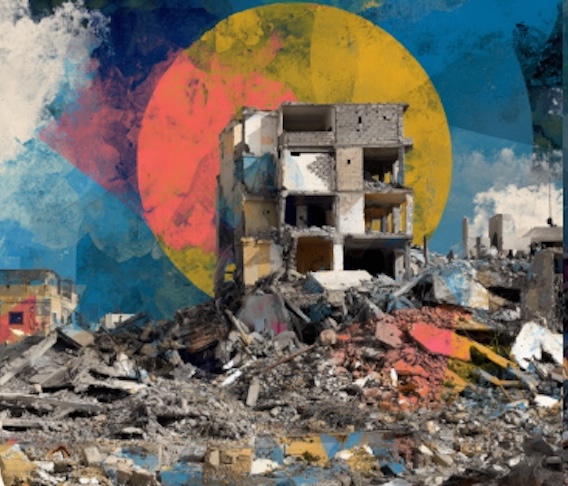After enduring one of history’s greatest atrocities, that of the Holocaust, Israeli leaders now propose a policy toward Palestinians that chillingly mirrors the horrors they once suffered: forcibly corralling civilians, including children, into sealed camp-like enclaves on the ruins of their homes—under military control and indefinite detention. With this plan, they threaten not just mass displacement, but the erasure of an entire people from their homeland. This proposal is genocide in all but name: targeting young people by exclusively screening men of fighting age and confining them en masse; deploying starvation and bombardment as tools of control; stripping a resilient population of their agency and right to remain on their land.
This is not a new chapter in Gaza’s suffering—it is the final act of a century-long strategy of erasure
The term “humanitarian city” is not just misleading—it is violent. It is a linguistic camouflage used to mask the machinery of forced displacement. Behind this word lies the claim, now repeated by both Israeli and American officials, that Palestinians are being offered aid and safety. But this is a lie. A lie no different from the one that frames their forced movement as “voluntary evacuation.” There is nothing voluntary about fleeing starvation, bombs, or white phosphorus. There is no humanitarian protection in being herded into rubble under military watch, cut off from the outside world.
This terminology—like “humanitarian city,” “safe zone,” “evacuation corridor”—is the vocabulary of colonial domination. It renders Palestinians as a population to be managed, not as people with inalienable rights. It erases their history, their sovereignty, and their right to return. It pretends that transfer is a matter of logistics, not a violation of international law. In truth, these words serve the architecture of a deeply systematic plan: the transformation of Palestinians from rightful landowners into permanent refugees.
It is not a humanitarian project. It is the climax of a policy of ethnic cleansing
The roots of this displacement stretch back to the 1800s, when Zionist settler-colonial designs began to imagine a Jewish homeland in a land already inhabited. That vision required the gradual but relentless removal of Palestinians. The Nakba of 1948 displaced over 700,000. The Naksa of 1967 added hundreds of thousands more. The wars of 2008, 2014, and now 2023–25 have not merely killed—they have dispossessed, one village, one camp, one neighborhood at a time. Today, the proposed “humanitarian city” on the ruins of Rafah is being pitched not as a temporary measure, but as a new permanent geography for a people Israel has long sought to disappear.
The systematic nature of this transfer must be confronted. It is not chaos; it is design. The targeting of youth, the destruction of homes and hospitals, the denial of aid, the sealing of borders—all form part of a strategy that pushes Palestinians toward permanent exile. The term “transfer,” often used coldly by military planners and politicians, is itself a colonial term. It flattens trauma into policy, and turns the expulsion of an entire people into an administrative task. It dehumanizes. It disfigures the truth. And it must be rejected.
The very act of ethnic cleansing—by any legal measure—must be named and opposed. Under the Geneva Conventions, the Rome Statute of the International Criminal Court, and every major human rights declaration, the forcible transfer of civilians under occupation is a war crime. To justify it in the name of “security” or “humanitarian concern” is not only immoral—it is illegal. Those who facilitate or remain silent about this crime are complicit. And yet, the international community continues to debate wording, not action.
Meanwhile, Arab countries, invoking the right of return, have largely shut their doors to fleeing Palestinians. While this stance aims to prevent permanent exile and preserve Palestinian claims to their land, in practice it has left Palestinians trapped—abandoned to starvation and bombardment, with no real sanctuary. The right of return is meaningless if there is no one left to return, and no land left to return to.

“Humanitarian,” Digital, Midjourney, 2025
What Israel offers today is not safety. It is not peace. It is not even exile. It is something far more cruel: an illusion of refuge atop the ruins of history, enforced by those who themselves arose from the ashes of genocide in Europe. That a state born from such horror now engineers another people’s erasure is a moral collapse too vast to comprehend.
But Palestinians have always resisted disappearance. They have survived wars, sieges, betrayals, and political abandonment. The “humanitarian city” may be built with barbed wire and drones, but it will never contain the spirit of a people who remember who they are and where they belong.
There is no humanitarian language that can justify mass displacement. There is no ethical framing that can cleanse the crimes being committed. If the world accepts this plan, it accepts the end of Palestine—not only as a land but as a living people.
And we will not accept that.
The views expressed in this article belong to the author and do not necessarily reflect the editorial policy of Middle East Monitor or Informed Comment.
 Unless otherwise stated in the article above, this work by Middle East Monitor is licensed under a Creative Commons Attribution-NonCommercial-ShareAlike 4.0 International License.
Unless otherwise stated in the article above, this work by Middle East Monitor is licensed under a Creative Commons Attribution-NonCommercial-ShareAlike 4.0 International License.

 © 2025 All Rights Reserved
© 2025 All Rights Reserved